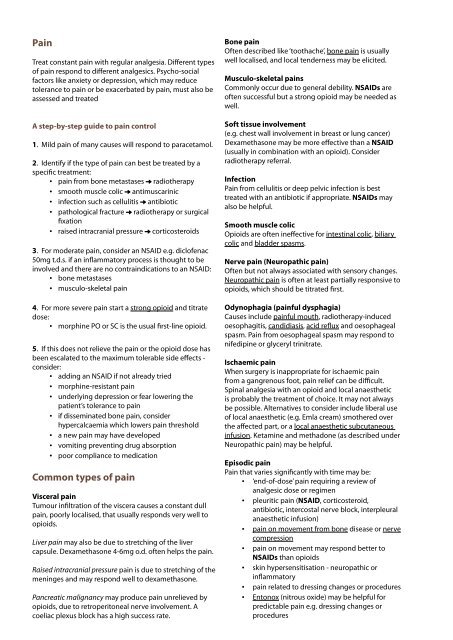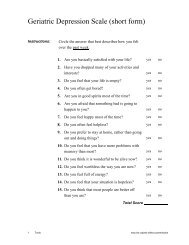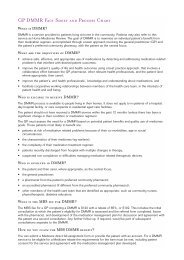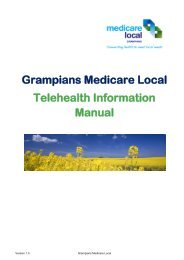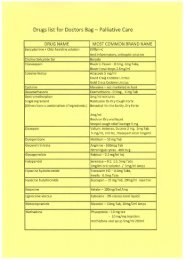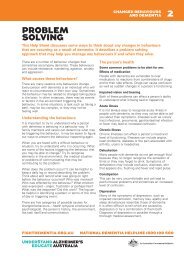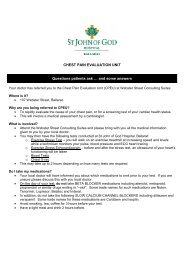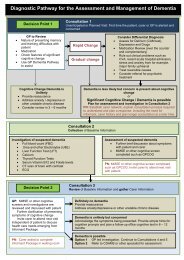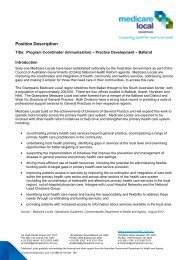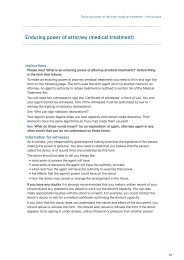Doctor's Bag: Palliative Care Information booklet - Grampians ...
Doctor's Bag: Palliative Care Information booklet - Grampians ...
Doctor's Bag: Palliative Care Information booklet - Grampians ...
Create successful ePaper yourself
Turn your PDF publications into a flip-book with our unique Google optimized e-Paper software.
Pain<br />
Treat constant pain with regular analgesia. Different types<br />
of pain respond to different analgesics. Psycho-social<br />
factors like anxiety or depression, which may reduce<br />
tolerance to pain or be exacerbated by pain, must also be<br />
assessed and treated<br />
A step-by-step guide to pain control<br />
1. Mild pain of many causes will respond to paracetamol.<br />
2. Identify if the type of pain can best be treated by a<br />
specific treatment:<br />
• pain from bone metastases radiotherapy<br />
• smooth muscle colic antimuscarinic<br />
• infection such as cellulitis antibiotic<br />
• pathological fracture radiotherapy or surgical<br />
fixation<br />
• raised intracranial pressure corticosteroids<br />
3. For moderate pain, consider an NSAID e.g. diclofenac<br />
50mg t.d.s. if an inflammatory process is thought to be<br />
involved and there are no contraindications to an NSAID:<br />
• bone metastases<br />
• musculo-skeletal pain<br />
4. For more severe pain start a strong opioid and titrate<br />
dose:<br />
• morphine PO or SC is the usual first-line opioid.<br />
5. If this does not relieve the pain or the opioid dose has<br />
been escalated to the maximum tolerable side effects -<br />
consider:<br />
• adding an NSAID if not already tried<br />
• morphine-resistant pain<br />
• underlying depression or fear lowering the<br />
patient’s tolerance to pain<br />
• if disseminated bone pain, consider<br />
hypercalcaemia which lowers pain threshold<br />
• a new pain may have developed<br />
• vomiting preventing drug absorption<br />
• poor compliance to medication<br />
Common types of pain<br />
Visceral pain<br />
Tumour infiltration of the viscera causes a constant dull<br />
pain, poorly localised, that usually responds very well to<br />
opioids.<br />
Liver pain may also be due to stretching of the liver<br />
capsule. Dexamethasone 4-6mg o.d. often helps the pain.<br />
Raised intracranial pressure pain is due to stretching of the<br />
meninges and may respond well to dexamethasone.<br />
Pancreatic malignancy may produce pain unrelieved by<br />
opioids, due to retroperitoneal nerve involvement. A<br />
coeliac plexus block has a high success rate.<br />
Bone pain<br />
Often described like ‘toothache’, bone pain is usually<br />
well localised, and local tenderness may be elicited.<br />
Musculo-skeletal pains<br />
Commonly occur due to general debility. NSAIDs are<br />
often successful but a strong opioid may be needed as<br />
well.<br />
Soft tissue involvement<br />
(e.g. chest wall involvement in breast or lung cancer)<br />
Dexamethasone may be more effective than a NSAID<br />
(usually in combination with an opioid). Consider<br />
radiotherapy referral.<br />
Infection<br />
Pain from cellulitis or deep pelvic infection is best<br />
treated with an antibiotic if appropriate. NSAIDs may<br />
also be helpful.<br />
Smooth muscle colic<br />
Opioids are often ineffective for intestinal colic, biliary<br />
colic and bladder spasms.<br />
Nerve pain (Neuropathic pain)<br />
Often but not always associated with sensory changes.<br />
Neuropathic pain is often at least partially responsive to<br />
opioids, which should be titrated first.<br />
Odynophagia (painful dysphagia)<br />
Causes include painful mouth, radiotherapy-induced<br />
oesophagitis, candidiasis, acid reflux and oesophageal<br />
spasm. Pain from oesophageal spasm may respond to<br />
nifedipine or glyceryl trinitrate.<br />
Ischaemic pain<br />
When surgery is inappropriate for ischaemic pain<br />
from a gangrenous foot, pain relief can be difficult.<br />
Spinal analgesia with an opioid and local anaesthetic<br />
is probably the treatment of choice. It may not always<br />
be possible. Alternatives to consider include liberal use<br />
of local anaesthetic (e.g. Emla cream) smothered over<br />
the affected part, or a local anaesthetic subcutaneous<br />
infusion. Ketamine and methadone (as described under<br />
Neuropathic pain) may be helpful.<br />
Episodic pain<br />
Pain that varies significantly with time may be:<br />
• ‘end-of-dose’ pain requiring a review of<br />
analgesic dose or regimen<br />
• pleuritic pain ( NSAID, corticosteroid,<br />
antibiotic, intercostal nerve block, interpleural<br />
anaesthetic infusion)<br />
• pain on movement from bone disease or nerve<br />
compression<br />
• pain on movement may respond better to<br />
NSAIDs than opioids<br />
• skin hypersensitisation - neuropathic or<br />
inflammatory<br />
• pain related to dressing changes or procedures<br />
• Entonox (nitrous oxide) may be helpful for<br />
predictable pain e.g. dressing changes or<br />
procedures


